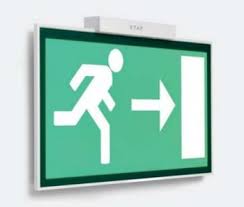The purpose of Emergency Lighting is to ensure adequate lighting to get everyone out of a building in the case of an emergency.All places of employment are legally required to provide and adequate means of exit in the case of an emergency. Emergency exits and routes are required to have proper lighting, even if there is a power outage. Emergency lighting must be provided in exit stairways, public corridors and other principal access to exits.
In order to ensure that the lighting is functioning properly and is able to last as long as needed, the Emergency Lighting System must be tested regularly.
More modern emergency lighting systems will be capable of testing themselves, but the majority of buildings will have older Emergency Lighting which require manual testing. How this is done will depend on the system in place, but the usual method is to use a special switch with a fishtail key to trigger the lighting.
The best way to organize your testing is to be systematic about it and keep an accurate record in a logbook. You should carry out different tests at regular intervals – weekly, monthly, quarterly, and/or annually. Daily checking is recommended for premises with Emergency Lights which stay on all the time. This just needs to be a visual check to ensure that all emergency lights are working. Those not working can be immediately repaired.
A monthly check should include cutting the power to all lighting temporarily
just to ensure that all non-maintained bulbs (ones which only come on in a power cut) are working. If you do not have a testing facility with a fish key, you can do this through fuse boxes.
Emergency lighting must be:
(a) designed to provide illumination for a duration of at least:
(1) 2 -hr in buildings with floor height of more than 18m above grade.
(2) 1/2-hr in buildings with floor height of not more than 18m above grade
(b) supplied by a source of energy separate from the primary electrical supply for the building, and
(c) designed to be automatically actuated when the power to the building is interrupted.
Illumination from Emergency Lighting shall be an average of at least 10 1x at floor or tread level, or 1 watt/m2 of floor space.
Your local fire authority has the right to check whether you are properly testing and maintaining your Emergency Lighting Systems.
Call Omni Life Safety to test your Emergency Lighting System.

